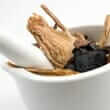Background
- Cascara is obtained from the dried bark of Rhamnus purshianus (Rhamnaceae), both a medicinal and poisonous plant. It is found in Europe, western Asia, and in North America from northern Idaho to the Pacific coast in mountainous areas. In Spanish, cascara sagrada means "sacred bark," perhaps because this woody shrub has provided relief for several constipated individuals. Cascara has been used as a tree bark laxative by Native American tribes and Spanish and Mexican priests since the 1800s. The cascara sagrada bark is aged for a year so that the active principles become milder, as freshly dried bark produces too strong a laxative for safe use.
- Cascara possesses purgative, toxic, therapeutic, and tonic activity. It is most commonly used as an anthraquinone stimulant laxative for bowel cleansing. Stimulant and cathartic laxatives are the most commonly abused laxatives and have the potential for causing long-term damage.
Risk Factors & Causes
These uses have been tested in humans or animals. Safety and effectiveness have not always been proven. Some of these conditions are potentially serious, and should be evaluated by a qualified healthcare provider.
Early studies have examined the use of cascara for bowel preparation. Evidence is insufficient to suggest effectiveness over conventional treatments for this indication.
Cascara sagrada is widely accepted as a mild and effective treatment for chronic constipation. However, limited data is available. Additional study is needed before a strong recommendation can be made.
*Key to grades:
References
Natural Standard developed the above evidence-based information based on a thorough systematic review of the available scientific articles. For comprehensive information about alternative and complementary therapies on the professional level, go to . Selected references are listed below.
- Borkje B, Pedersen R, Lund GM, et al. Effectiveness and acceptability of three bowel cleansing regimens. Scand J Gastroenterol 1991;26(2):162-166.
View Abstract - Borrelli F, Mereto E, Capasso F, Orsi P, Set al. Effect of bisacodyl and cascara on growth of aberrant crypt foci and malignant tumors in the rat colon. Life Sci 9-7-2001;69(16):1871-1877.
View Abstract - Chen HC, Hsieh WT, Chang WC, et al. Aloe-emodin induced in vitro G2/M arrest of cell cycle in human promyelocytic leukemia HL-60 cells. Food Chem Toxicol 2004;42(8):1251-1257.
View Abstract - Food and Drug Administration, HHS. Status of certain additional over the-counter drug category II and III active ingredients. Final rule. Fed Regist 2002;67(90):31125-31127.
View Abstract - Hangartner PJ, Munch R, Meier J, et al. Comparison of three colon cleansing methods: evaluation of a randomized clinical trial with 300 ambulatory patients. Endoscopy 1989;21(6):272-275.
View Abstract - Huang Q, Shen HM, Ong CN. Inhibitory effect of emodin on tumor invasion through suppression of activator protein-1 and nuclear factor-kappaB. Biochem Pharmacol 7-15-2004;68(2):361-371.
View Abstract - Jung H.A, Chung HY, Yokozawa T, et al. Alaternin and emodin with hydroxyl radical inhibitory and/or scavenging activities and hepatoprotective activity on tacrine-induced cytotoxicity in HepG2 cells. Arch Pharm Res 2004;27(9):947-953.
View Abstract - Kuo PL, Lin TC, Lin,CC. The antiproliferative activity of aloe-emodin is through p53-dependent and p21-dependent apoptotic pathway in human hepatoma cell lines. Life Sci 9-6-2002;71(16):1879-1892.
View Abstract - Lai GH, Zhang Z, Sirica AE. Celecoxib acts in a cyclooxygenase-2-independent manner and in synergy with emodin to suppress rat cholangiocarcinoma growth in vitro through a mechanism involving enhanced Akt inactivation and increased activation of caspases-9 and -3. Mol.Cancer Ther 2003;2(3):265-271.
View Abstract - Liu JB, Gao XG, Lian T, et al. [Apoptosis of human hepatoma HepG2 cells induced by emodin in vitro]. Ai.Zheng. 2003;22(12):1280-1283.
View Abstract - Marchesi M, Marcato M, Silvestrini C. [Clinical experience with a preparation containing cascara sagrada and boldo in the therapy of simple constipation in the elderly]. G.Clin.Med. 1982;63(11-12):850-863.
View Abstract - Mereto E, Ghia M, Brambilla G. Evaluation of the potential carcinogenic activity of Senna and Cascara glycosides for the rat colon. Cancer Lett 3-19-1996;101(1):79-83.
View Abstract - Nadir A, Reddy D, Van Thiel DH. Cascara sagrada-induced intrahepatic cholestasis causing portal hypertension: case report and review of herbal hepatotoxicity. Am.J.Gastroenterol. 2000;95(12):3634-3637.
View Abstract - Stern FH. Constipation--an omnipresent symptom: effect of a preparation containing prune concentrate and cascarin. J Am Geriatr Soc 1966;14(11):1153-1155.
View Abstract - Tramonte SM, Brand MB, Mulrow CD, et al. The treatment of chronic constipation in adults. A systematic review. J Gen.Intern.Med 1997;12(1):15-24.
View Abstract







